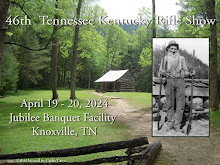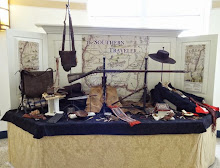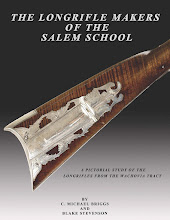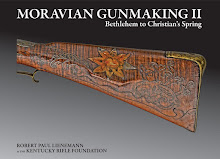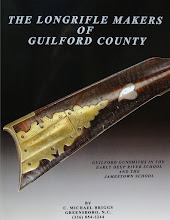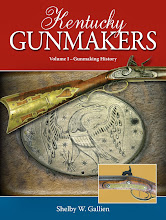Tuesday, August 31, 2021
Monday, August 30, 2021
Friday, August 27, 2021
Thursday, August 26, 2021
The Bill Myers Collection by Morphy Auctions
Description
This fine pipe tomahawk dates to about 1780 and is one of the finest of its type, featuring excellent metalwork and a rich history. The piece is featured on pages 30 and 81 of "Tomahawks, Pipe Axes of the American Frontier" by John Baldwin. It is shown on page 83 of "Accouterments" and page 129 of "Accouterments IV", both by James R. Johnston. The tomahawk is also featured on page 73 of "Steel Canvas" by R.L. Wilson. In addition, it is accompanied by a silver NRA medal, winner of the National Rifle Association's Ten Best Weapons Award in 1984. The tomahawk is also featured on page 85 of "Indian Tomahawks and Frontiersmen Belt Axes" by Hartzler & Knowles. Inlaid on head with large brass "AM" for Alexander Mackenzie (1764 - 1820). The tomahawk was owned and carried by Mackenzie in 1793 when he became the first European to reach the Pacific Ocean 12 years prior to the Lewis and Clark Expedition. Mackenzie was born in1 764 on the Isle of Lewis, Scotland. In 1774, he and his father sailed to New York. In 1776 during the Revolutionary War, his father and uncle joined the King's Royal Regiment of New York, both as lieutenants. For his safety, as the son of a Loyalist, young Alexander was sent to Montreal in 1778. By 1779, he was an apprentice with Finlay and Gregory, one of the most prominent fur trading companies in Montreal. That same year, Finlay & Gregory merged with other firms to form the North West Company. Alexander Mackenzie impressed the company's directors and was sent into the west, eventually leading the push for the North West's inward expansion. In competition with the Hudson's Bay Company, the Northwesterners ultimately prevailed due to posts Mackenzie had helped to create. By 1795, the North West Trading Company controlled more than two thirds of the Canadian fur trade. Mackenzie was an adventurer and in 1785, he was stationed in Saskatchewan, joining Peter Pond at the Athabasca River in 1787. He then set out to explore the large river flowing out of the Great Slave Lake, which Pond believed led west to the Pacific Ocean. This led to the account of his travels entitled "Journal of a Voyage performed by order of the N.W. Company, in a Bark Canoe Athabasca to the Pacific Ocean in Summer 1789". He and his party travelled 1075 miles of what would later be named the Mackenzie River in only 14 days. They discovered it ran north into the Northern Ocean, not the Pacific, as Pond had hoped. In 1791, Mackenzie returned to London to study new advancements in the measure of longitude and obtained new surveying equipment. He returned to North America in 1792 and once again set out to find a route to the Pacific. He departed from Fort Chipewyan in October 1792 with two Indian guides, a dog, his cousin Alexander MacKay and six Canadian voyageurs. They built Fort Fork to winter at in November of 1792. They left the fort in May of 1793 and followed the route of the Peace River. He crossed the Great Divide and found the upper reaches of the Fraser River, but was advised by the local natives to follow a trade route by traveling the West Road River, crossing the Coast Mountains, and descending the Bella Coola River to the sea. He reached the Pacific Coast on July 20, 1793 at Bella Coola, British Columbia. He had travelled more than 2300 miles in three months. The first overland journey across North America by a European is commemorated in his famous inscription in a rock "Alexander Mackenzie, from Canada, by land, the twenty-second of July, one thousand seven hundred and ninety-three." In 1801, the journals of his exploratory journeys were published and attracted wide attention. A first edition copy is included with the tomahawk. In an entry for August 1793, he mentions his pipe tomahawk. President Thomas Jefferson presented an American Edition of Mackenzie's book to Meriwether Lewis, who carried it with him on the Lewis & Clark Expedition in 1804. Mackenzie was knighted in 1802 for his efforts. In 1812, he returned to Scotland and had two children before his death in 1820 at the age of 56. He died from Bright's disease and is buried near Avoch on the Black Isle. The tomahawk itself has a iron head measuring 5-1/2" overall with a 3-1/4" blade with 1/4" steel crescent cutting edge measuring 1-7/8". The left side of the blade is inlayed with a neatly done "AM" in brass block letters. There is a molding at the back of the blade on both sides. Oval eye with engraved silver cap. Faceted 1-1/16" bowl. The original bowed haft measures 18" overall and is of ash. There is one silver band and two engraved silver diamond shaped inlays below the band. The end has a silver cap with an integral turned silver mouthpiece. The tomahawk is accompanied by its original homespun carrying strap and fitted leather sheath. The full brown leather sheath with flap is decorated with diagonal tooling and the strap is woven cotton and linen with decoration.
CONDITION: Tomahawk is very good, head retains a pleasing even brown patina, cutting edge has been sharpened. Haft and inlays are excellent, showing a few scattered marks from use. Sheath and strap are in remarkable condition for their age. Strap shows some fraying to edges and staining. Sheath shows minor scuffing and loss to stitching. Complete with a display case, several books regarding the Canadian fur trade and Mackenzie's expeditions and an archive of photographs and documentation on the tomahawk and Alexander Mackenzie. The silver NRA medal is also included. A truly extraordinary and extremely well documented historic and attractive identified pipe tomahawk.
PROVENANCE: Pre-1968 it was housed at an unknown Canadian Museum. 1968-1982 it was owned by dealer Arnold Marcus Chernoff, Ltd. of Lincolnshire, IL. It has been in Bill Myers' Collection since 1982. DMG Blade Length: 2" Overall Length: 18" Paperwork: Provenance, Large Map

























































